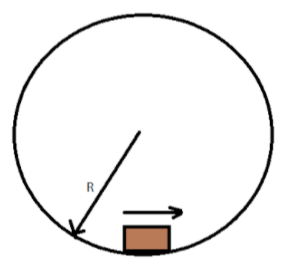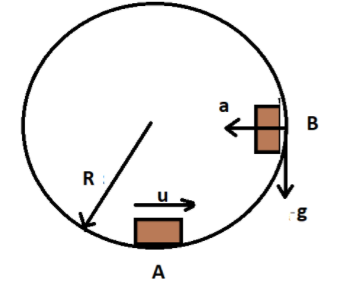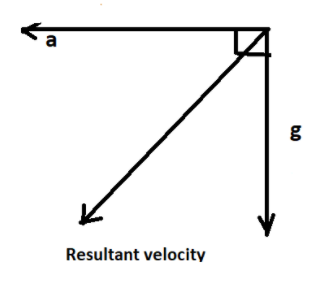
A particle is given an initial speed $u$ inside a smooth spherical shell of radius $R = 1m$ such that it is just able to complete the circle. Acceleration of the particle when its velocity is vertical is:

A) $g\sqrt {10} $
B) $g$
C) $g\sqrt 2 $
D) \[g\sqrt 6 \]
Answer
216.3k+ views
Hint: To solve this question, we have to calculate the resultant of the tangential and centripetal acceleration. We all know the value of tangential acceleration which is equal to the value of acceleration due to gravity. The centripetal acceleration can be calculated by using velocity and the radius of the circle.
Formulae used:
${v_l} = \sqrt {5gl} $
Here ${v_l}$ is the velocity at the lowest point, $g$ is the acceleration due to gravity and $l$ is distance from center.
$a = \dfrac{{{v^2}}}{r}$
Here $a$ is the centripetal acceleration, $v$ is the tangential velocity at point B and $r$ is the radius of the circle.
Complete step by step solution:
We know that in a circle the velocity at the lowest most position will be,
${v_l} = \sqrt {5gl} $
Here ${v_l}$ is the velocity at the lowest point, $g$ is the acceleration due to gravity and $l$ is the distance.
So, $u = \sqrt {5gl} $

Applying conservation of energy at points A and B, we get
$ \Rightarrow \dfrac{1}{2}m{u^2} = \dfrac{1}{2}m{v^2} + m\left( - \right)gl$
Here $u$ is the velocity at point A, $v$ is the velocity at point B, $m$ is the mass of the box, $g$ is the acceleration due to gravity and $l$ is the distance from the center.
The negative sign in gravity is because of its downwards action.
Simplifying the equation, we get,
$ \Rightarrow {u^2} = {v^2} - 2gl$
Putting the value of $u$, we get
$ \Rightarrow {v^2} = {\left( {\sqrt {5gl} } \right)^2} - 2gl$
$ \Rightarrow {v^2} = 3gl$
$ \Rightarrow v = \sqrt {3gl} $
So the value of tangential velocity at point B is $\sqrt {3gl} $.
We know that,
$ \Rightarrow a = \dfrac{{{v^2}}}{r}$
Here $a$ is the centripetal acceleration, $v$ is the tangential velocity at point B and $r$ is the radius of the circle.
Putting the values of $v$ and $r$, we get
$ \Rightarrow a = 3g$

From the above diagram, the resultant acceleration acting on the body will be,
$ \Rightarrow {a_{net}} = \sqrt {{a^2} + {g^2} + 2ag\cos 90^\circ } $
$ \Rightarrow {a_{net}} = \sqrt {{a^2} + {g^2}} $
Putting the value of $a = 3g$ we get,
$ \Rightarrow {a_{net}} = \sqrt {9{g^2} + {g^2}} = g\sqrt {10} $
So the net acceleration acting on the body will be $g\sqrt {10} $.
Hence option (A) is the correct option.
Note: In a vertical circle,
1. The velocity at the lower most position is $v = \sqrt {5gl} $
2. The velocity at the horizontal position is $v = \sqrt {3gl} $
3. The velocity at the top most position is $v = \sqrt {gl} $
Here $g$ is the acceleration due to gravity and $l$ is the distance from the centre. Also for particles in a vertical circle, both centripetal acceleration and acceleration due to gravity acts on it.
Formulae used:
${v_l} = \sqrt {5gl} $
Here ${v_l}$ is the velocity at the lowest point, $g$ is the acceleration due to gravity and $l$ is distance from center.
$a = \dfrac{{{v^2}}}{r}$
Here $a$ is the centripetal acceleration, $v$ is the tangential velocity at point B and $r$ is the radius of the circle.
Complete step by step solution:
We know that in a circle the velocity at the lowest most position will be,
${v_l} = \sqrt {5gl} $
Here ${v_l}$ is the velocity at the lowest point, $g$ is the acceleration due to gravity and $l$ is the distance.
So, $u = \sqrt {5gl} $

Applying conservation of energy at points A and B, we get
$ \Rightarrow \dfrac{1}{2}m{u^2} = \dfrac{1}{2}m{v^2} + m\left( - \right)gl$
Here $u$ is the velocity at point A, $v$ is the velocity at point B, $m$ is the mass of the box, $g$ is the acceleration due to gravity and $l$ is the distance from the center.
The negative sign in gravity is because of its downwards action.
Simplifying the equation, we get,
$ \Rightarrow {u^2} = {v^2} - 2gl$
Putting the value of $u$, we get
$ \Rightarrow {v^2} = {\left( {\sqrt {5gl} } \right)^2} - 2gl$
$ \Rightarrow {v^2} = 3gl$
$ \Rightarrow v = \sqrt {3gl} $
So the value of tangential velocity at point B is $\sqrt {3gl} $.
We know that,
$ \Rightarrow a = \dfrac{{{v^2}}}{r}$
Here $a$ is the centripetal acceleration, $v$ is the tangential velocity at point B and $r$ is the radius of the circle.
Putting the values of $v$ and $r$, we get
$ \Rightarrow a = 3g$

From the above diagram, the resultant acceleration acting on the body will be,
$ \Rightarrow {a_{net}} = \sqrt {{a^2} + {g^2} + 2ag\cos 90^\circ } $
$ \Rightarrow {a_{net}} = \sqrt {{a^2} + {g^2}} $
Putting the value of $a = 3g$ we get,
$ \Rightarrow {a_{net}} = \sqrt {9{g^2} + {g^2}} = g\sqrt {10} $
So the net acceleration acting on the body will be $g\sqrt {10} $.
Hence option (A) is the correct option.
Note: In a vertical circle,
1. The velocity at the lower most position is $v = \sqrt {5gl} $
2. The velocity at the horizontal position is $v = \sqrt {3gl} $
3. The velocity at the top most position is $v = \sqrt {gl} $
Here $g$ is the acceleration due to gravity and $l$ is the distance from the centre. Also for particles in a vertical circle, both centripetal acceleration and acceleration due to gravity acts on it.
Recently Updated Pages
Circuit Switching vs Packet Switching: Key Differences Explained

Mass vs Weight: Key Differences Explained for Students

Alpha, Beta, and Gamma Decay Explained

Alpha Particle Scattering and Rutherford Model Explained

Angular Momentum of a Rotating Body: Definition & Formula

Apparent Frequency Explained: Formula, Uses & Examples

Trending doubts
JEE Main 2026: Application Form Open, Exam Dates, Syllabus, Eligibility & Question Papers

JEE Main Correction Window 2026 Session 1 Dates Announced - Edit Form Details, Dates and Link

Derivation of Equation of Trajectory Explained for Students

Hybridisation in Chemistry – Concept, Types & Applications

Understanding the Angle of Deviation in a Prism

Understanding Collisions: Types and Examples for Students

Other Pages
JEE Advanced Marks vs Ranks 2025: Understanding Category-wise Qualifying Marks and Previous Year Cut-offs

Units And Measurements Class 11 Physics Chapter 1 CBSE Notes - 2025-26

NCERT Solutions For Class 11 Physics Chapter 8 Mechanical Properties Of Solids

Motion in a Straight Line Class 11 Physics Chapter 2 CBSE Notes - 2025-26

NCERT Solutions for Class 11 Physics Chapter 7 Gravitation 2025-26

How to Convert a Galvanometer into an Ammeter or Voltmeter




